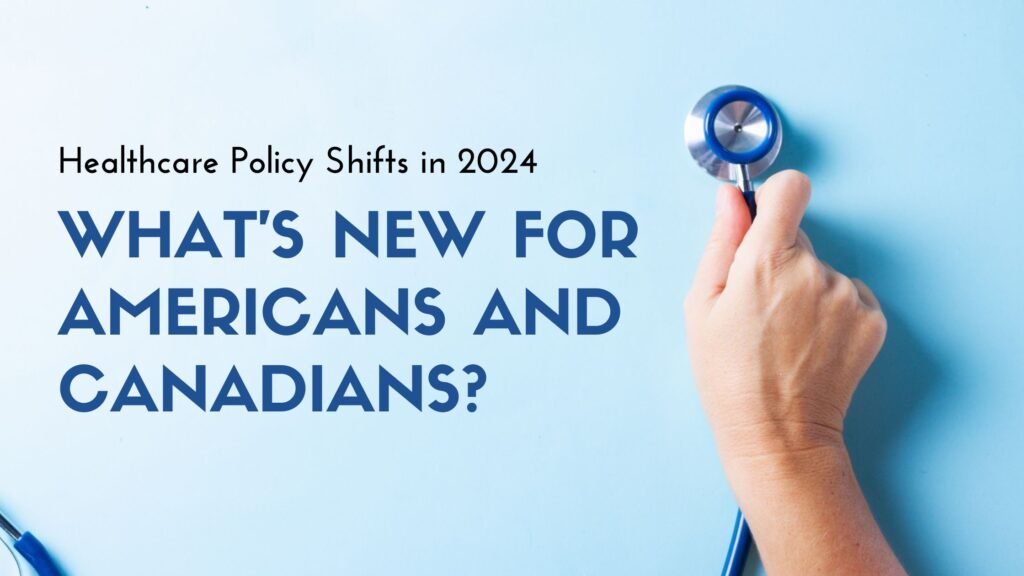As we move through 2024, healthcare policy is once again at the forefront of political discussions in both the United States and Canada. With changing demographics, economic pressures, and evolving public health challenges, both nations have introduced significant shifts in their healthcare policies.
This blog examines these changes, providing insights into what they mean for citizens and healthcare professionals alike.
1. U.S. Healthcare Policy Changes in 2024
In 2024, the United States saw several significant shifts in its healthcare policies. These changes aim to address long-standing issues such as the affordability of healthcare, access to essential services, and the integration of new technologies in patient care.
Expansion of the Affordable Care Act (ACA)
The Affordable Care Act (ACA) has undergone further expansion in 2024, with new provisions to increase accessibility and affordability. Key changes include:
- Increased Subsidies: The federal government has introduced higher subsidies for low- and middle-income families, reducing out-of-pocket costs for insurance premiums.
- Expanded Medicaid Eligibility: Several states have expanded Medicaid eligibility, allowing more low-income individuals to qualify for coverage.
- Introduction of Public Option: A public insurance option is now available in several states, providing a more affordable alternative to private insurance plans.
These changes are expected to significantly reduce the number of uninsured Americans. According to recent statistics, the uninsured rate has dropped from 8.6% in 2023 to 7.4% in early 2024, indicating a positive impact from these reforms (source: HealthCare.gov).
Telehealth Integration and Regulations
The rapid adoption of telehealth during the COVID-19 pandemic has prompted the U.S. government to solidify its role in the healthcare system. In 2024, new regulations were introduced to standardize telehealth services across states:
- Cross-State Licensing: Healthcare providers can now offer telehealth services across state lines without needing separate licenses for each state.
- Reimbursement Parity: Telehealth services are now reimbursed at the same rate as in-person visits by Medicare and Medicaid, ensuring fair compensation for healthcare providers.
- Data Security Measures: New cybersecurity standards have been implemented to protect patient data during virtual consultations.
The integration of telehealth is expected to improve access to healthcare, particularly in rural and underserved areas. A recent study shows that 60% of rural patients now prefer telehealth consultations over in-person visits, citing convenience and accessibility (source: TeleHealth.HHS.gov).
2. Canadian Healthcare Policy Developments in 2024
Canada’s healthcare system, while publicly funded and universally accessible, is facing its own set of challenges. In response, the Canadian government has introduced several policy changes in 2024 aimed at improving the quality and efficiency of healthcare services.
Investments in Mental Health Services
One of the most notable shifts in Canada’s healthcare policy is the increased focus on mental health. The government has pledged significant investments to expand access to mental health services:
- Mental Health Parity: New legislation requires that mental health services be covered to the same extent as physical health services under provincial health plans.
- Expansion of Telepsychiatry: Funding has been allocated to expand telepsychiatry services, making mental health care more accessible to remote communities.
- Youth Mental Health Initiatives: Targeted programs have been introduced to address the rising mental health challenges among Canadian youth, including school-based mental health services and crisis intervention programs.
According to recent data, there has been a 15% increase in the utilization of mental health services in Canada since the implementation of these policies (source: Public Health Agency of Canada).
3. Addressing Healthcare Workforce Shortages in Both Countries
Both the U.S. and Canada are grappling with healthcare workforce shortages, exacerbated by the pandemic and an aging population. In 2024, both countries have introduced policies to address these challenges.
U.S. Strategies
- Incentives for Healthcare Workers: The U.S. has introduced new financial incentives, such as loan forgiveness programs and bonuses, to attract healthcare professionals to underserved areas.
- Expansion of Training Programs: The government has increased funding for medical and nursing schools to expand enrollment and produce more healthcare professionals.
Canadian Strategies
- International Recruitment: Canada has streamlined the process for recognizing foreign medical credentials, making it easier for internationally trained professionals to join the Canadian healthcare workforce.
- Retention Bonuses: Provinces are offering retention bonuses and improved working conditions to prevent burnout and keep experienced healthcare workers in the system.
These efforts are beginning to show results. The U.S. has seen a 10% increase in medical school enrollments, while Canada has welcomed over 5,000 internationally trained healthcare professionals since the beginning of 2024 (source: World Health Organization).
4. Innovations in Healthcare Technology and Data Management
In 2024, both the U.S. and Canada are advancing healthcare through technological innovations and improved data management.
U.S. Advances
- AI in Diagnostics: AI tools are increasingly used to enhance diagnostic accuracy, such as improving cancer detection by 20%. These tools analyze medical data, including imaging scans and patient histories, to provide faster and more accurate diagnoses (source: HealthIt.gov).
- EHRs Interoperability: New standards for Electronic Health Records (EHRs) interoperability have been introduced, ensuring seamless data sharing among healthcare providers. This enhances continuity of care, especially for patients with complex needs.
- Wearable Health Tech: Wearable devices that track health metrics like heart rate and glucose levels are now widely used. They are integrated with EHRs for real-time monitoring, with 35% of Americans using such technology as of 2024 (source: U.S. Centers of Disease Control and Prevention).
Canadian Innovations
- National Health Data Network: Canada’s new National Health Data Network connects healthcare providers nationwide, allowing for secure and efficient sharing of patient data. This system aims to reduce medical errors and improve overall patient care (source: Public Health Agency of Canada).
- AI-Powered Analytics: Canadian healthcare is utilizing AI to analyze large datasets for better resource allocation and trend identification. AI tools are also used for predicting flu patterns, which helps in preparing for seasonal outbreaks.
- Blockchain for Data Security: To enhance data privacy, Canada is adopting blockchain technology. This ensures that patient data is securely stored and accessed only by authorized individuals, protecting against breaches and ensuring compliance with privacy laws.
These advancements are set to improve healthcare delivery and data management, making systems more efficient and secure across North America.
Conclusion
The healthcare policy shifts of 2024 in the U.S. and Canada mark a significant evolution in addressing healthcare access, affordability, and technological integration. With advancements such as expanded insurance coverage, enhanced telehealth services, and cutting-edge data management solutions, both countries are taking crucial steps toward improving healthcare systems. While challenges remain, these reforms and innovations hold promise for a more efficient, equitable, and responsive healthcare landscape.
As these policies take effect, their impact will be closely monitored, shaping the future of healthcare in North America and offering valuable insights for global healthcare advancements.





Leave a Reply